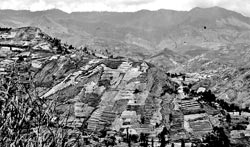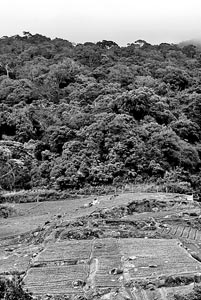
Regrowing lost RainforestsRainforests influence weather patterns and are of prime importance for rainfall, water, fresh air and survival of mankind. Sri Lanka's forest cover has been dwindling from the time of British Colonial rule here, where thousands of acres of forest cover were cleared for plantations of coffee, rubber, coconut, tea, etc. Conservation International estimates that only around 1.5 percent of the island's original forest remains. Over the past 15 years (1990-2005), Sri Lanka has experienced one of the highest deforestation rates of primary forests in the world. The country has lost more than 35 percent of its old-growth forest cover, while total forest cover was diminished by almost 18 percent. Worse, since the close of the 1990s, deforestation rates have increased by more than 25 percent. The costs of deforestation, such as increased soil erosion, decreased access to valuable natural resources, and diminished ecological services are already evident, particularly among rural communities.
Industrialization, cultivations, encroachments and destruction of forests in the war area, illegal felling of trees and a host of other factors are taking their toll on the forests in this land, creating a very alarming situation. Of the required rate of 15% minimum rainforest cover, Sri Lanka now has only 2%, reveals Dr. Ranil Senanayake, Chairman of Rainforest Rescue International(RRI). Dr. Senanayake, an environmental scientist who has done extensive studies in ecology for over 40 years has been working towards finding a solution to the crisis. RRI, a non-profit making private organization dedicated to regeneration and safeguarding of rain forests in this country, works with rural communities to stop and reverse environmental degradation. Dr. Senanayake has been a Senior Research Fellow at the University of Melbourne where he worked on the development of land care strategy and a Senior Lecturer at the Monash University at Melbourne where he taught Applied Forest Ecology. He has been a consultant for the United Nations Environment Programme (UNEP), United Nations Development Programme (UNDP) and the World Bank on matters of biodiversity and forest rehabilitation.
He is currently doing projects in Equador, Peru, Guatamala, Costa Rica, Zimbabwe, Philippines, Vietnam, Canada, Sri Lanka and is a visiting Lecturer in Australia. RRI's projects include the Sinharaja Biomonitoring Education Programme developed in partnership with Sewa Lanka in 2005 to increase knowledge among 200 young students, Analog Forestry Training Centre and Botanic Gardens, Mirahawatta, the Sinharaja-Kanneliya Biodiversity Corridor and Baddegama Rescue Nursery and Botanic Garden.In this interview with The Sunday Times, Dr. Senanayake spoke of the massive problem facing the country and how best it could be overcome. What have been the harmful effects of this massive deforestation over the years? Loss of ecosystem stability. The loss of the huge capital of topsoil, increase of floods, decrease in water quality. It has also impacted the basic functioning of the hydrological cycle of the island from water retention to the generation of Cloud Condensation Nuclei (CCN).
Apart from the British colonial era clearing thousands of acres for cultivation of coffee, tea, rubber and coconut, what other factors destroyed our forests from post-independence time onwards? Wrong economic policies. It is the acceptance of open-ended consumerism as 'development' and the inability to take a long term view. Development progammes like the Mahaweli, the on-going war and mindless borrowing of money to squander in non productive areas have all had its impact. Apart from the national wild life parks and sanctuaries which are the only visible large green areas when one peruses a map, are the strict natural forest reserves counted as part of rainforests ? Only if one considers montane forests on high mountains. Otherwise none. In a forest in terms of bio-diversity, only 1%is comprised of trees - in terms of bio-diversity 99% or more are the shrubs, bushes, birds, insects, animals, micro-organisms - all that. In Pinus forests there is no undergrowth. If you plant only trees you do not have a forest. It is just a monoculture. In the present approach to forestry we have lost the forest for the trees. Sinharaja, is the best known rain forest. What are the other rainforests worthy of mention? Kanneliya, Nakiyadenya and Dedugala complex is the last large remnant of Rainforest other than Sinharaja. However other smaller patches also exist with no proper protection and can be cleared on the whim of any politician or bureaucrat. How is work progressing on the rain forest corridor that is proposed to link the Sinharaja forest with the Kanneliya forest? And what is the motive behind this linkage ? Steadily.Today we have control of another 18 acres and it is increasing. Lamentably most of the support has come from outside the country at a time when our citizens should be talking a greater interest. You have suggested that the denuded Mahaweli upper catchments region is to be treated as an ESD (Ecologically Sustainable Development) test area, with the support of the government. Is it working out? Not there, but we are setting out a Sustainable Developed Zone in the Gin Ganga watershed. Specifically along the corridor. We have entered into an MOU with Counterpart International to promote and help develop their Forest Garden Programme in Sri Lanka. Forest Gardens are being enriched with biodiversity among communities along the Gin Ganga, through the application of Analog Forestry. This activity contributes significantly to the Rainforest Corridor, being constructed by RRI. What is the best example of a successful rainforest regenerated country in the world that Sri Lanka can take a lesson from ? Costa Rica. After their colonial experience they had lost almost all their forest cover. It is a mountainous region and all the soil was eroding. The government took a very strong view of the situation and gave all the encouragement to the people through programmes to regenerate and safeguard the forests. Today I personally know people who have forest gardens in their land who are being paid 45 - 50 Dollars per year by the government just to maintain the forests as they are. The government is getting these monies from International donors. Costa Ricans are proud that they have a clean, beautiful country. What sort of time period will it take to build up a rainforest ? In 20 years you can get maturity to manifest. Are there successful rainforest regenerated private lands in Sri Lanka and if so where are these ? (So that others could follow the example). The work on the demonstration has began at Hiniduma ( contact www.earthrestoration.org for details.) RRI(Rainforest Rescue International) is having a drive towards creating rainforests by providing plants, guidance and advice. How can interested members of the public get involved ? Visit the RRI office and projects ay 37C, Wakunugoda Road, Galle or call 2232585.
|
|| Front
Page | News | Editorial | Columns | Sports | Plus | Financial
Times | International | Mirror | TV
Times | Funday
Times || |
| |
Copyright
2007 Wijeya
Newspapers Ltd.Colombo. Sri Lanka. |


